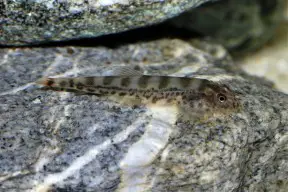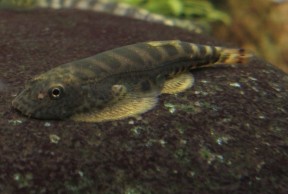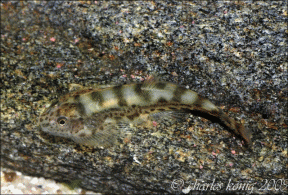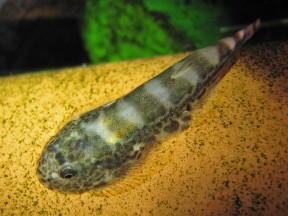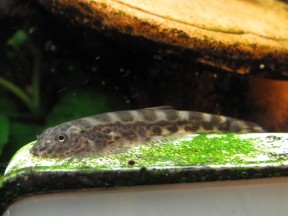Hypergastromyzon humilis
Etymology
Hypergastromyzon: from the Greek hyper, meaning ‘over, above’ (used here as a prefix), and the generic name Gastromyzon.
humilis: from the Latin humilis, meaning ‘low, on the ground’, in reference to the depressed body shape of this species.
Classification
Order: Cypriniformes Family: Gastromyzontidae
Distribution
Known only from the Sungai Melawi river basin which is part of the much larger Kapuas system in Kalimantan Barat (West Kalimantan) province, Indonesian Borneo.
Type locality is ‘Sungei Tamang, small forest stream flowing into Sungai Pinoh opposite mouth of Sungei Kelawai, Kalamaantan Barat, Borneo’.
Habitat
Hypergastromyzon spp. are obligate dwellers of swift, shallow forest streams containing clear, oxygen-saturated water and most commonly occurring in runs and riffles.
Substrates are generally composed of gravel, rocks, boulders or bedrock carpeted with a rich biofilm formed by algae and other micro-organisms. Aquatic plants are uncommon and while riparian vegetation may be present these loaches are most abundant in unshaded or partially-shaded zones.
Field observations have revealed that individuals almost always position themselves facing into the flow, either along the sides, behind or under rocks, their specialised morphology (see ‘Notes’) allowing them to feed and maintain position without being swept away.
In nature H. humilis occurs sympatrically with Gastromyzon contractus, G. ridens and G. praestans of which the former pair are also endemic to the Melawi drainage.
Maximum Standard Length
30 – 35 mm.
Aquarium SizeTop ↑
An aquarium with base dimensions of 45 ∗ 30 cm is large enough to house a group.
Maintenance
Most importantly the water must be clean and well-oxygenated so we suggest the use of an over-sized filter as a minimum requirement.
Turnover should ideally be 10-15 times per hour so additional powerheads, airstones, etc. should also be employed as necessary.
Base substrate can either be of gravel, sand or a mixture of both to which should be added a layer of water-worn rocks and pebbles of varying sizes.
Aged driftwood can also be used but avoid new pieces since these usually leach tannins that discolour the water and reduce the effectiveness of artificial lighting, an unwanted side-effect since the latter should be strong to promote the growth of algae and associated microorganisms.
Exposed filter sponges will also be grazed, and some enthusiasts maintain an open filter in the tank specifically to provide an additional food source.
Although rarely a feature of the natural habitat aquatic plants can be used with adaptable genera such as Microsorum, Crinum and Anubias spp. likely to fare best. The latter are particularly useful as their leaves tend to attract algal growth and provide additional cover.
Since it needs stable water conditions and feeds on biofilm this species should never be added to a biologically immature set-up, and a tightly-fitting cover is necessary since it can literally climb glass.
While regular partial water changes are essential aufwuchs can be allowed to grow on all surfaces except perhaps the viewing pane.
Water Conditions
Temperature: For general care 20 – 24 °C is recommended but it can withstand warmer conditions provided dissolved oxygen levels are maintained.
pH: 6.0 – 7.5
Hardness: 36 – 215 ppm
Diet
Much of the natural diet is likely to be composed of benthic algae plus associated micro-organisms which are rasped from solid surfaces.
In captivity it will accept good-quality dried foods and meatier items like live or frozen bloodworm but may suffer internal problems if the diet contains excessive protein.
Home-made foods using a mixture of natural ingredients bound with gelatin are very useful since they can be tailored to contain a high proportion of fresh vegetables, Spirulina and similar ingredients.
For long-term success it’s best to provide a mature aquarium with a plentiful supply of algae-covered rocks and other surfaces.
If unable to grow sufficient algae in the main tank or you have a community containing numerous herbivorous fishes which consume what’s available quickly it may be necessary to maintain a separate tank in which to grow algae on rocks and switch them with those in the main tank on a cyclical basis.
Such a ‘nursery‘ doesn’t have to be very large, requires only strong lighting and in sunny climates can be kept outdoors. Algal type is also important with diatoms and softer, green varieties preferred to tougher types such as rhodophytic ‘black brush’ algae.
Gastromyzontids are often seen on sale in an emaciated state which can be difficult to correct. A good dealer will have done something about this prior to sale but if you decide to take a chance with severely weakened specimens they’ll initially require a constant source of suitable foods in the absence of competitors if they’re to recover.
Behaviour and CompatibilityTop ↑
This species is quite delicate and shouldn’t be kept with aggressive or particularly dominant relatives such as Beaufortia, Pseudogastromyzon or Sewellia spp.
Better choices include members of Gastromyzon, Sinogastromyzon, Protomyzon and Erromyzon as well as riverine gobies such as Stiphodon or Sicyopus spp., while nemacheilid loaches are best omitted entirely.
For the upper levels diminutive cyprinids such as Microdevario, Tanichthys and smaller Danio species are ideal.
Hypergastromyzon spp. tend to exist in loose aggregations in nature but since they’re only imported occasionally as bycatch among shipments of Gastromyzon it may take some time to build up a group.
Sexual Dimorphism
The most obvious external characteristics are the shape of the head and body when viewed from above or below.
Females are comparatively heavy-framed, and the snout is almost continuous with the pectoral fins. Males are slighter and the snout is squarer in shape with the pectoral fins emerging almost at right-angles.
Reproduction
Unrecorded.
NotesTop ↑
This species is not traded specifically but may sometimes be found as bycatch among shipments of wild-collected Gastromyzon species.
H. eubranchus is the only other species in the genus and like H. humilis has a highly-localised distribution being endemic to the Batang (river) Ai in the Lupar drainage, Sarawak state, Malaysian Borneo.
The two can be told apart by a combination of characters of which the most useful to aquarists are: presence of 7-8 cream-coloured bars on the dorsal surface in H. humilis (vs. 5-6 in H. eubranchus); pelvic fins completely fused (vs. partially fused); small, restricted gill opening (vs. large gill opening); 18 pelvic-fin rays (vs. 19-21); 28 pectoral-fin rays (vs. 24-25).
The differences in pelvic-fin structure and gill openings led Roberts to redefine the genus when describing H. eubranchus, whereas Tan (2006) expressed doubts that the two are even congeneric but was unable to reach a definitive conclusion in the absence of fresh material.
At any rate both species can be easily differentiated from Gastromyzon and Neogastromyzon spp. by observing the mouthparts which are relatively small, measuring around one-third to half of the head width, and lacking papillae in Hypergastromyzon while in both other genera the mouth is wide, almost equal to head width, and the lower lip papillated to some extent.
Hypergastromyzon spp. have specialised morphology adapted to life in fast-flowing water. The paired fins are orientated horizontally, head and body flattened, and pelvic fins fused together.
These features form a powerful sucking cup which allows the fish to cling tightly to solid surfaces. The ability to swim in open water is greatly reduced and they instead ‘crawl’ their way over and under rocks.
The family Gastromyzontidae is currently considered valid as per Kottelat (2012).
It contains a number of genera which had formerly been included in several families and subfamilies, most recently Balitoridae, of which the most well-known in the aquarium hobby include Beaufortia, Formosania, Gastromyzon, Pseudogastromyzon, Hypergastromyzon, Liniparhomaloptera, Sewellia, and Vanmanenia.
References
- Roberts, T. R., 1989 - Memoirs of the California Academy of Sciences 14: i-xii + 1-210
The freshwater fishes of western Borneo (Kalimantan Barat, Indonesia). - Kottelat, M., 2012 - Raffles Bulletin of Zoology Supplement 26: 1-199
Conspectus cobitidum: an inventory of the loaches of the world (Teleostei: Cypriniformes: Cobitoidei). - Roberts, T. R., 1991 - Japanese Journal of Ichthyology 37(4): 333-336
Hypergastromyzon eubranchus, a new species of gastromyzontin loach (Homalopteridae) from Sarawak. - Tan, H. H., 2006 - Natural History Publications (Borneo), Kota Kinabalu: 1-245
The Borneo Suckers. Revision of the torrent loaches of Borneo (Balitoridae: Gastromyzon, Neogastromyzon).
